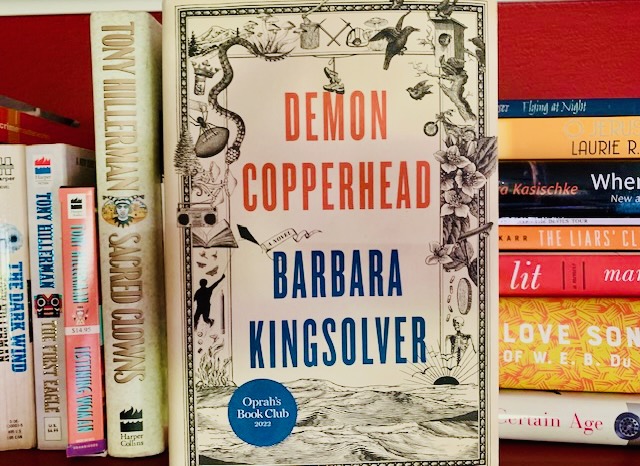https://www.petwantsclt.com/petwants-charlotte-ingredients/ When, at the age of 15, I first read David Copperfield, Charles Dickens’ classic novel of the protagonist’s struggle to rise above child poverty in a society seemingly structured to keep him poor, it was the first book that made me tear up at the end, that glorious end with the angelic Agnes ever “pointing upward.” I wasn’t sure that Barbara Kingsolver’s Demon Copperhead could possibly elicit anything like that response from my jaded, seen-it-all-before, read-it-all-before consciousness. Re-imagining the quintessentially British Dickens’ nineteenth-century story as a twenty-first century slice of American Appalachian life? How’s that likely to work?
Order Tramadol Well, of course, it was likely to bomb spectacularly. But instead, what I found from the book’s very first paragraph was a voice that explodes off the page with both confidence and world-weariness, with stoicism and self-knowledge, with everything the character is going to exhibit in the rest of this blockbuster of a novel. My review of David Copperfield I’ve already submitted as part of this list. As the winner of the Pulitzer Prize for Fiction in 2023, Demon Copperhead is the most recent novel on my list, and as such has not been around long enough to make its way onto most “great books” lists published prior to 2023. It does, however, appear on the 2024 list published by Truelit sub-reddit called “Truelit’s 100 Best Books of the Quarter Century,” compiled by votes from readers word-wide, as number 79. The New York Times, also in 2024, published a well-publicized list of the “100 Best Books of the 21st Century,” on which they listed Demon Copperhead as number 61. Later that year, as a direct response to the New York Times’ list, the Book Enthusiast Substack published its own “100 Best Books of the 21st Century,” on which Kingsolver’s book is much more highly regarded as number 6. And finally, in a readers’ poll published by the New York Times, again as an answer to their own official list, called “Readers Pick Their 100 Best Books of the 21st Century,” Demon Coppperhead came in as the number 1 favorite of readers. And it takes up the position as number 53 on my list of the 100 MOST LOVABLE NOVELS IN THE ENGLISH LANGUAGE.
Dickens’ David famously opens with, “Whether I shall turn out to be the hero of my own life, or whether that station will be held by anybody else, these pages must show.” By contrast, Kingsolver’s Copperhead (whose real name is Damon Fields, but he has red hair, so…) opens with, “First, I got myself born. A decent crowd was on hand to watch and they’ve always given me that much: the worst of the job was up to me, my mother being let’s just say out of it.”
In this life, you make your own choices, and if you’re going to get anywhere, and your mother is in and out of rehab constantly, you have to do it yourself, Damon tells you at the beginning. You think there’s going to be a hero in your life? Think again. There’s just you, trying to make your way in a world that’s stacked against you. Here’s a voice that, in its tone of genuine down-home rural Americanism sounds a lot more like Huck Finn than anybody in Dickens. Like Huck, he has a memorable way of putting things in his colorful American vernacular: He’s “the Eagle Scout of trailer trash,” he tells us at one point.
And I don’t mean to say that you must be familiar with David Copperfield to enjoy Demon Copperhead. You can follow the plot, empathize with the characters and absorb the themes of Kingsolver’s book without ever having heard of Dickens. But it does add something to the overall experience of the book if you know the Copperfield story. In particular, there’s a bit of fun for readers when they can recognize by name a Kingsolvian character intended to parallel a Dickensian one. Thus, when Damon’s abusive stepfather bears the name of “Stoner,” it’s easy to see the connection with David’s equally cruel stepfather, whose name happens to be “Murdstone.” Damon’s kind neighbors, the Peggots, clearly recall David’s friends the Peggottys and Clara Peggotty, David’s early nurse and lifelong friend. Dickens’ charming and narcissistic James Steerforth, who for a while promises to be that “hero of my own life” David looks forward to in his opening sentence, finds his counterpoint in Kingsolver’s Sterling Ford, nicknamed Fast Forward, star quarterback on the high school football team and, for a while, Damon’s idol. Copperfield’s “child wife” Dora Spenlowe is echoed in Kingsolver’s Dori, and when Damon falls for his needy, childish Dori you don’t have to remember David Copperfield to know that relationship is going to be a disaster, but it helps.
Occasionally Kingsolver’s parallel characters are direct mirror images of Dickens’, as in the case of Damon’s grandmother Betsy and her eccentric friend Mr. Dick, who liked flying kites, mirroring David’s great-aunt Betsy and her eccentric friend Mr. Dick who also liked flying kites. Sometimes there’s more of a difference: Damon’s short-term foster father Mr. McCobb has a few things in common with David’s Mr. Micawber, lack of steady employment and perpetual new schemes to get rich among them, but Micawber is a well-meaning screwup, while McCobb is just trying to take advantage of the system. And Dickens’ Uriah Heep is a far more insidious villain than Kingsolver’s assistant coach U-Haul Pyles, whose downfall is far less precipitous than Heep’s in Dickens. And then there is “Angus” Winfield, daughter of the high school football coach and Damon’s foster-sister during the best and worst years of his life, who clearly parallels David’s guardian angel, Agnes Wickfield, and who you know from the first is going to be a major influence in Damon’s life.
Of course, knowing Dickens gives you an idea of the role these characters are going to play in the story. But the plot of Demon Copperhead is not therefore predictable, as Kingsolver translates these characters’ motivations and effects on the protagonist into a completely different milieu of time and place. Ultimately, what’s important about the influence of Dickens on Kingsolver’s book is not the superficial correspondences of plot or character, but rather their very significant agreement in terms of theme and authorial intent. In an afterword to her novel, Kingsolver writes, “I’m grateful to Charles Dickens for writing David Copperfield, his impassioned critique of institutional poverty and its damaging effects on children in his society. Those problems are still with us. In adapting his novel to my own place and time, working for years with his outrage, inventiveness, and empathy at my elbow, I’ve come to think of him as my genius friend.”
It is precisely those social evils that Kingsolver has directly in her sights in this novel: Most broadly she attacks the institutional poverty of former coal-mining areas of her native Appalachia—a fact she lays unequivocally at the door of the owners and exploiters of those coal fields and the powerful political forces that supported them. Damon muses on the causes and effects of these forces after hearing his most influential teacher, Mr. Armstrong, describe the history of Appalachia:
Once upon a time we had our honest living that was God and country. Then the world turns and there’s no God anymore, no country, but it’s still in your blood that coal is God’s gift and you want to believe. Because otherwise it was one more scam in the fuck-train that’s railroaded over these mountains since George Washington rode in and set his crew to cutting down our trees. Everything that could be taken is gone. Mountains left with their heads blown off, rivers running black. My people are dead of trying, or headed that way, addicted as we are to keeping ourselves alive.
Kingsolver goes on to present the effects of that poverty on children, especially children whose parents have been victims of that poverty and are dead or imprisoned. She attacks the ineptitude and bureaucracy of child welfare services, the abuse of the system of foster care that allows people like Damon’s foster parents to take children solely for the sake of taking the monthly support money, or for obtaining slave labor like the tobacco farmer who first fosters Damon. She attacks a justice system that will accept the testimony of an abusive stepfather rather than the word of the abused child. Toward the end of the novel Damon reflects on all these forces arrayed against them that seem designed to keep him and his peers down:
Live long enough, and all things you ever loved can turn around to scorch you blind. The wonder is that you could start life with nothing, end with nothing, and lose so much in between.
But more than anything else Kingsolver attacks the opioid crisis. Damon, who has a brief period when it seems he may escape the cesspool of his luckless life through success on the gridiron as a high school football star, suffers a terrible knee injury for which he is prescribed opioid pain relievers to which he becomes hopelessly addicted, and Kingsolver’s indictment of the doctors, salesmen, druggists, and especially the Sackler-owned Purdue Pharma is merciless in the novel. Damon thinks back later on where he began his downward slide:
What’s an oxy, I’d asked. That November it was still a shiny new thing. OxyContin, God’s gift for the laid-off deep-hole man with his back and neck bones grinding like bags of gravel. For the bent-over lady pulling double shifts at Dollar General with her shot knees and ADHD grandkids to raise by herself. For every football player with some of this or that torn up, and the whole world riding on his getting back in the game. This was our deliverance. The tree was shaken and yes, we did eat of the apple.
It truly seems like there is no way out for Damon—but as David Copperfield had a talent in writing that finally helped pull him out of poverty, the fact that Damon has a talent for drawing—all he has left after football—does give him a ray of hope. I won’t spoil the end by telling you whether he’s able to use it. But I will say that, despite some reviewers who have faulted the novel for being simply an endless litany of hardships from which the characters have no escape, Damon for one (like David Copperfield before him) finds a way out of the cycle of poverty and hardship. Near the novel’s conclusion he reflects:
I’ve tried in this telling, time and time again, to pinpoint the moment where everything starts to fall apart. Everything, meaning me. But there’s also the opposite, where some little nut cracks open inside you and a tree starts to grow. Even harder to nail. Because that thing’s going to be growing a long time before you notice. Years maybe. Then one day you say, Huh, that little crack between my ears has turned into this whole damn tree of wonderful
In the end, Kingsolver is not simply the heir of Dickens in recasting his most personal novel; she is more importantly the spiritual heir of Dickens’ novel of social criticism, something you don’t see much of any more. Where is Dickens today? Where are the Zolas? The Sinclair Lewises? The John Steinbecks? Gone. But we’ve still got Barbara Kingsolver.


This is a great review Jay! It makes me want to re-David Copperfield and also read Demon Copperhead.